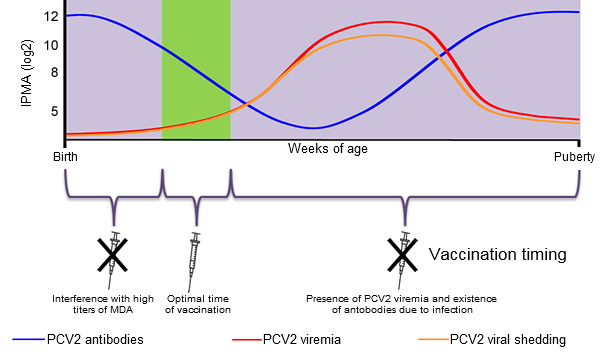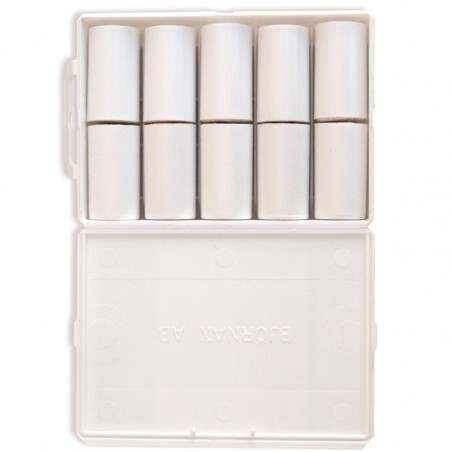Efficacy of porcine circovirus type 2 (PCV2) commercial vaccines has been vastly demonstrated by the drastic reduction of the impact of porcine circovirus diseases (PCVDs) under field conditions. Indeed, the wide and constant use of such vaccines has lead,in most farms, to a PCV2 subclinical infection scenario and, eventually, reaching seronegative batches at slaughter age. In all cases, it seems that vaccination against PCV2 is in most scenarios economically worthy.
Currently, the most common age of piglet vaccination against PCV2 infection is at 3-4 weeks of age (around weaning). However, little information is available whether this is the age getting the best profit by means of vaccination. The factors to be considered for deciding the optimal time of vaccination against PCV2 are the following:

Maternally derived immunity (MDI): It is known that high levels of maternally derived antibodies (MDA) at the vaccination time may cause a lower humoral response (interference with the seroconversion) elicited by the vaccine. As a reference, this interference is observed when antibodies titres are > than 10 log2 IPMA (immunoperoxidase monolayer assay). However, cell-mediated immune response induced by the vaccines seems not to be affected by the MDA levels. In order to avoid such interference or to achieve higher vaccine efficacy, a delayed piglet vaccination should be considered. This might be the case when a sow and piglet vaccination strategy is planned.
Maturity of the immune system of the piglet: The maturity degree of the immune system of a newborn piglet is still not clearly defined. However, in a study it was found that PCV2 vaccination of seronegative piglets at 5 days of age induced protective immunity against subsequent experimental PCV2 challenge. This indicates that,at least at that age,the piglet immune system is already mature enough to produce a protective immune response. Nevertheless, at the farm level it is not common to find seronegative piglets at that age, mainly due to the pre-existence of MDI.
PCV2 infection dynamics: Generally, PCV2 viraemia starts at the end of the nursery or at the beginning of fattening periods, however, is usually quite variable depending on the farm.Very early infection dynamics can also occur and is indeed considered as one of the risk factors to suffer from PCVDs. These early circulations can occur when the sow herd is not stable. Therefore, sow vaccination should be applied in order to achieve an earlier protective immunity in the piglets. The percentage of PCV2-infected newborn piglets is usually low, although it can be variable among farms and batches. However, a prevalence of almost 40% of PCV2 infection in serum of pre-suckling piglets was described in a study in which several farms with PCV2 subclinical infection were assessed. Since this high prevalence has not been described in any other study, it might be considered an exception. Horizontal transmission is very efficient in susceptible piglets. Therefore, it is important to protect the animals (via sow vaccination) prior to the infection. Furthermore, it has been experimentally demonstrated that vaccination of PCV2 viraemic and seropositive piglets leads to a humoral and cellular immune response able to reduce PCV2 viraemia after challenge. However, it is very likely that the efficacy of vaccinating already viraemic pigs is not as good as vaccinating non-viraemic pigs with sufficient anticipation to the infection timing.
Immunosuppression: Any factor that may cause immunosuppression at the time of vaccination can reduce vaccination efficacy. Among these factors, secondary infections or concurrent diseases, concomitant administration of other vaccines, stress and malnutrition are included.
The effect of all these factors in the vaccine efficacy will depend on the age at which the vaccination is performed. Although PCV2 vaccines are routinely used in most of the worldwide porcine production systems, peer-reviewed studies comparing the efficacy of PCV2 vaccines in animals vaccinated at different ages are scarce. In such regards, a study to evaluate the efficacy of different vaccination programs in PCV2 subclinically infected piglets has been conducted. Animals were vaccinated at 3, 6 or 10 weeks of age with the same vaccine. In addition, one group of animals was kept unvaccinated. All pigs were monitored and bled at different sampling points from 2 to 25 weeks of age. In that study, PCV2 vaccination at 3 or 6 weeks of age yielded similar virological and serological results. Both strategies were effective, since they were able to significantly reduce the number of viraemic animals in comparison to unvaccinated group. On the contrary, PCV2 vaccination at 10 weeks of age was probably too late as coincided with the onset of PCV2 viraemia, being the percentage of infected pigs at this moment not significantly different from the non-vaccinated ones.
In conclusion, the optimal age for piglet vaccination would be the one that combines the presence of low values of MDI and the development of a protective immunity against PCV2 before the occurrence of natural infection (Figure 1).

Figure 1. Determining the optimal time for PCV2 piglet vaccination.







